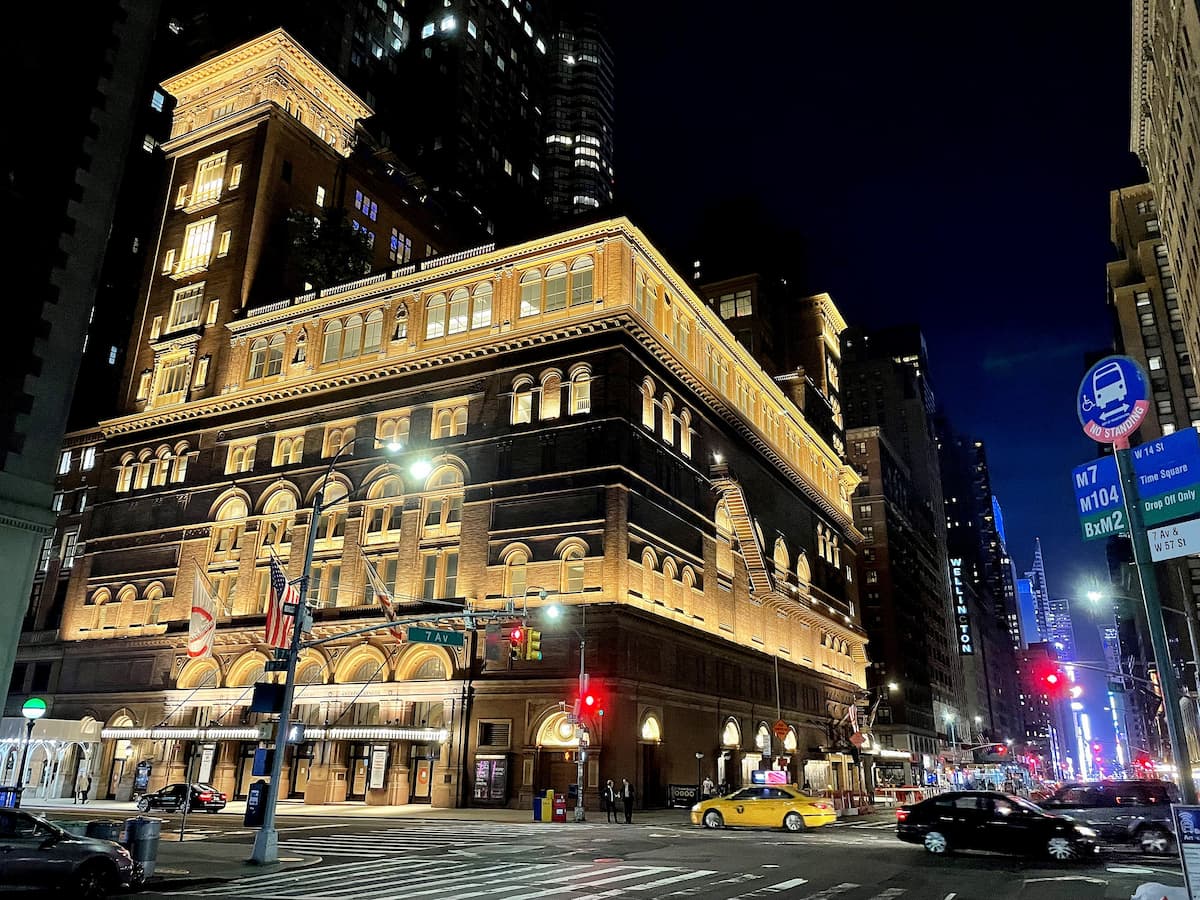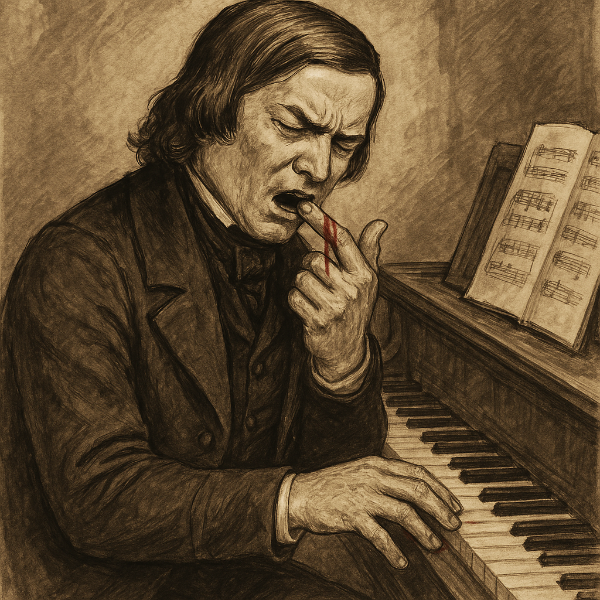“How do you get to Carnegie Hall?” the old joke goes. “Practice, practice, practice,” is the customary response.
However, if you’re feeling lazy, there is another easier way you can visit: by watching films or TV shows that use Carnegie Hall as a setting and were actually filmed there.

Carnegie Hall at night © Wikipedia
Today we’re looking at seven movies and TV shows that were filmed at Carnegie Hall.
A Corny Concerto (1943)
Okay, so we’re starting out with a bit of a cheat. The Looney Tunes short “A Corny Concerto” isn’t set at Carnegie Hall per se, but it is set at a parody venue called Corny-Gie Hall, a clear reference to the storied New York venue.
This eight-minute cartoon begins with the character of Elmer Fudd dressed up as a conductor struggling with a malfunctioning tuxedo. (This bumbling character is a reference to a real-life figure: lecturer, critic, and broadcaster Deems Taylor, who provided commentary for the New York Philharmonic when it gave its performances at Carnegie Hall.)
We then enter a magical cartoon forest. Porky Pig and his hunting dog try to hunt Bugs Bunny to the soundtrack of Strauss’s Tales from the Vienna Woods. Bugs escape in a variety of clever ways.
Fudd then introduces a performance of The Blue Danube. A family of white swans swims to the music. Daffy Duck tries to join but is rebuffed. Next, a buzzard spots the family and hijinks ensue. Daffy manages to save the cygnets from the buzzard and in the end, he is allowed to swim into the distance.
Interestingly, the real-life non-cartoon Carnegie Hall didn’t appear on film until 1947, when it appeared in a movie called…
Carnegie Hall (1947)
It’s the early 1900s. and Irish immigrant Nora Ryan has gotten a job as a cleaning woman at Carnegie Hall.
One day while cleaning in the auditorium, she is smitten by a tempestuous piano soloist named Tony Salerno. After fighting with the conductor, he storms offstage: he has a hot temper and an alcohol problem.
Nora falls in love with him anyway. They eventually get married and have a son named Tony Junior. Unfortunately, Tony Senior dies by falling down a staircase while drunk, and Nora has to raise their child alone. In honor of her late husband, she makes sure that her son learns how to play piano.
When Tony Junior becomes an adult, he joins a jazz band (much to his mother’s horror). He also falls in love with the lead singer of that band.
Will Tony be able to merge the European classical music tradition with the American tradition of jazz?
The plot may be thin and more than a bit melodramatic, but it doesn’t really matter. The real star of this film is Carnegie Hall itself, as well as the celebrity musicians who agreed to make cameos, including Jascha Heifetz, Arthur Rubinstein, Gregor Piatigorsky, Fritz Reiner, Leopold Stokowski, and many others.
New York Philharmonic Young People’s Concerts (1958-1972)
The New York Philharmonic began offering concerts catered to children and families all the way back in 1885. This series evolved into an offering called the Young People’s Concerts in 1914. In 1924, conductor Ernest Schelling began lecturing from the stage during these performances, adding an educational component.
When Leonard Bernstein was named music director of the New York Philharmonic in 1958, he began hosting the Young People’s Concerts. These were broadcast on television to audiences across America and the world, and they proved to be hugely influential.
These hugely popular broadcasts – narrated by a young, debonair conductor – were the first time that many people saw film footage of Carnegie Hall’s interior.
Music of the Heart (1999)
The 1999 film Music of the Heart is based on the true story of music teacher Roberta Guaspari, played here by Meryl Streep.
The movie follows Roberta as she begins teaching violin at a public school in Harlem. She proves to be an effective leader and inspirational teacher, and over the course of a decade, her orchestra program has expanded to multiple schools.
However, disaster strikes when the budget for the music program is slashed, and Roberta loses her job. She, the students, parents, and alumni join forces to mount a benefit concert to keep the program going. Will they be able to ensure that every student gets the arts education they deserve?
We won’t spoil how the film gets there, but the final scene takes place in Carnegie Hall. Like the 1947 Carnegie Hall, it features cameos from big-name musicians of the era: Mark O’Connor, Joshua Bell, Itzhak Perlman, Isaac Stern, and others.
Florence Foster Jenkins (2016)
Amusingly, Meryl Streep returned to Carnegie Hall in 2016 to film another movie. Florence Foster Jenkins tells the story of the real-life socialite and singer of the same name, who became a sensation in early twentieth-century New York for her terrible singing, her misplaced confidence, and the legion of fans she acquired along the way.
Jenkins made many of her appearances at privately organized events and never concertized for the general public. However, in 1944, when she was in her mid-seventies, she made an exception to her rule and booked Carnegie Hall to give a one-night-only performance for the public.
The concert took place on 25 October 1944. Tickets were such a hot commodity that the entire venue sold out weeks before the show, and at least two thousand people were turned away.
Her manager recalled, “[She] created a pandemonium in the place. One famous actress had to be carried out of her box because she became so hysterical.”
Five days later, she died of a massive heart attack while shopping for sheet music.
In the movie Florence Foster Jenkins, this ludicrous and weirdly heartwarming evening is reproduced for the cameras, with Streep giving a tour de force performance in the title role.
The Marvelous Mrs. Maisel, Season 4, Episode 8 (2022)
The Marvelous Mrs. Maisel (2017-2023) is a stylish Amazon Prime TV show that tells the story of a Jewish homemaker from New York City named Midge Maisel. Despite the rampant sexism of the 1950s and 1960s, after her husband leaves her and throws her picture-perfect life into turmoil, Midge decides to sacrifice everything to pursue her dream of becoming a great stand-up comedian.
Although the character is fictional, the show’s writers have Midge meet real-life people and visit real-life locations on her adventures.
One of the show’s most affecting crossovers between fact and fiction happens during the season four finale, when Midge goes to see her friend and colleague Lenny Bruce perform a legendary set at Carnegie Hall. This performance actually happened on 4 February 1961 in the middle of a raging blizzard. Despite the weather, there was a full house.
After Bruce’s triumph, he begs Midge to change her approach to her career. The two comedians have a beautifully filmed argument about audience expectations, personal identity, and the art and business of standup.
Carnegie Hall was shut down during the pandemic, so it was available for the showrunners to use as a shooting location. Once you’ve watched the scene, it’s impossible to imagine this pivotal conversation happening anywhere else.
Maestro (2023)
The action begins when Leonard Bernstein, played by the film’s director Bradley Cooper, gets a telephone call in his Carnegie Hall apartment (yes, at one point, there were apartments in Carnegie Hall).
The call is shocking: the day’s scheduled conductor has fallen ill with the flu. Bernstein will have to direct the New York Philharmonic in the scheduled program…without a rehearsal, and with millions listening on the radio.
Cooper uses various vintage filming techniques to evoke different eras of Bernstein’s life. If the trailer snippet of a young Bernstein striding onstage in black and white is any indication, we’re in for a cinematography treat.
Maestro recreates Bernstein’s legendary Philharmonic debut from 1943, and is a striking parallel with the footage from 1947’s Carnegie Hall, bringing our exploration of Carnegie Hall in film full-circle.
For more of the best in classical music, sign up for our E-Newsletter




